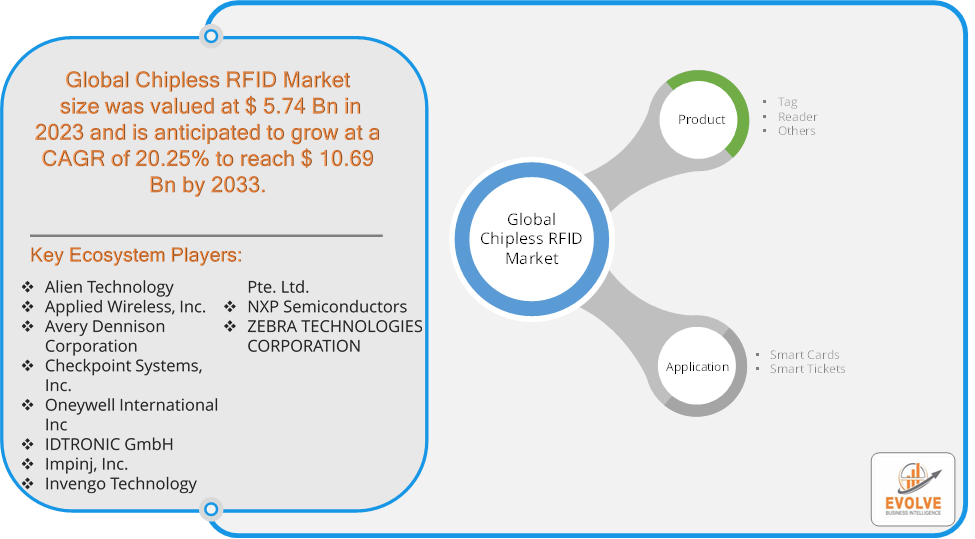Chipless RFID Market Soars: 20.25% CAGR Predicted

Evolve Business Intelligence has published a research report on the Global Chipless RFID Market, 2023–2033. The global Chipless RFID market is projected to exhibit a CAGR of around 20.25%during the forecast period of 2023 to 2033.
Evolve Business Intelligence has recognized the following companies as the key players in the global Chipless RFID Market: Alien Technology, Applied Wireless, Inc., Avery Dennison Corporation, Checkpoint Systems, Inc., Oneywell International Inc, IDTRONIC GmbH, Impinj, Inc., Invengo Technology Pte. Ltd., NXP Semiconductors, ZEBRA TECHNOLOGIES CORPORATION.
For More Information : https://evolvebi.com/report/chipless-rfid-market-analysis/
 Chipless RFID Market Highlights
Chipless RFID Market Highlights
The Global Chipless RFID market is projected to be valued at USD 10.69 Billion by 2033, recording a CAGR of around 20.25% during the forecast period. The chipless RFID market encompasses the development and application of Radio Frequency Identification (RFID) systems that operate without an integrated circuit (chip). These systems use materials or patterns to encode data, making them potentially cheaper and more durable than traditional RFID tags. Applications of chipless RFID include asset tracking, inventory management, and anti-counterfeiting measures. Key advantages are reduced costs, longer lifespan, and better performance in harsh environments. However, challenges include lower data storage capacity and more complex signal processing requirements. The market is driven by advancements in materials science and increased demand for cost-effective RFID solutions.
The COVID-19 pandemic has led to supply chain disruptions leading to supply shortages or lower demand in the chipless RFID market. The travel restrictions and social-distancing measures have resulted in a sharp drop in consumer and business spending and this pattern is to continue for some time. The end-user trend and preferences have changed due to the pandemic and have resulted in manufacturers, developers, and service providers adopting various strategies to stabilize the company.
Chipless RFID Segmental Analysis
The global Chipless RFID market has been segmented based on Product Type, Application
Based on Product Type, the market is segmented based on Tag, Reader. The Tag segment dominates the chipless RFID market, as tags are the primary components required for various applications such as asset tracking, inventory management, and anti-counterfeiting.
Based on Applications, the market has been divided into the Smart Cards, Smart Tickets, Others. The Smart Cards segment dominates the chipless RFID market, driven by its extensive use in secure access control, payment systems, and identification applications across various sectors.
For More Information : https://evolvebi.com/report/chipless-rfid-market-analysis/
Chipless RFID Regional Analysis
The Chipless RFID market is divided into five regions: North America, Europe, Asia-Pacific, South America, and the Middle East, &Africa. North America holds a dominant position in the Chipless RFID Market. In North America, the chipless RFID market is experiencing significant growth due to the region’s advanced technological infrastructure and high adoption rate of innovative solutions across industries such as retail, healthcare, and logistics. The demand for efficient supply chain management, anti-counterfeiting measures, and enhanced asset tracking systems drives market expansion. Additionally, increasing investment in IoT integration and the presence of key market players contribute to the robust development of chipless RFID technology in the region. The Asia-Pacific region has indeed emerged as the fastest-growing market for the Chipless RFID industry. The chipless RFID market in the Asia-Pacific region is growing rapidly, driven by the expanding industrial and retail sectors, particularly in countries like China, Japan, and India. Increasing adoption of advanced tracking and inventory management solutions, coupled with rising investments in IoT and smart technologies, fuels market growth. The region’s large manufacturing base and supply chain networks further boost demand for cost-effective and efficient RFID solutions. Additionally, supportive government initiatives and policies promoting technology adoption contribute to the market’s expansion in Asia-Pacific.


